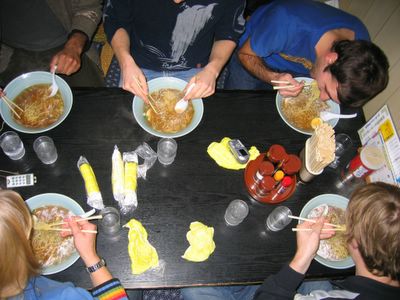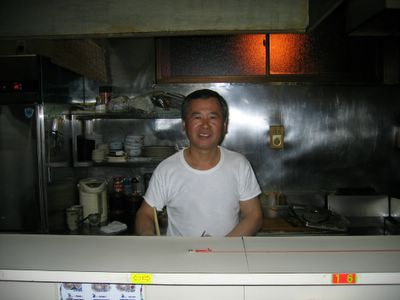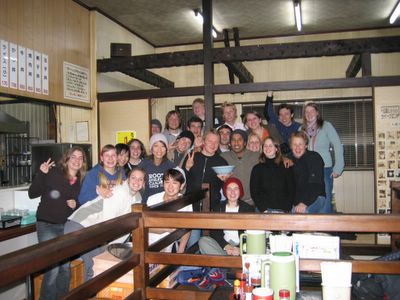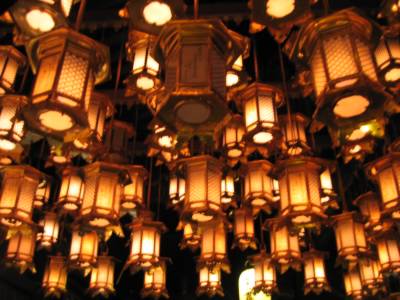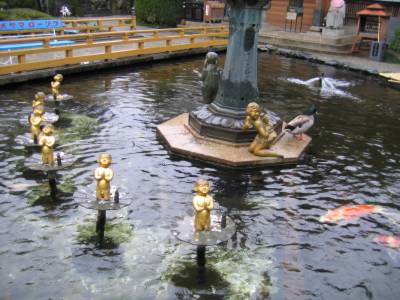Today was soup for lunch. Because everyone else was eating whale. Again. This time, I asked a few questions of my lunch buddies, all of them in the second grade. "Have you ever eaten whale before? Do you eat whale at home? Ever seen it before?" Three of nine kids had eaten whale once before, at school lunch in grade one. The rest of them were as puzzled as I, had never seen the stuff before. "Teacher, what's this? Is it any good? It smells funny. And it looks funny, too." The teacher did a good job, though, assured them that whale is delicious and that no, it doesn't smell or look funny. She couldn't fool me, though. I didn't touch a bite.
Onegaishimasu
The Amazing Adventures of Jon and Nancy
Monday, January 31, 2005
Sunday, January 30, 2005

The Ramen Challenge was a huge success. People drove from as far as Nakamura, two hours west of here, for the opportunity to pound some ramen. Out of the ten challengers, Vineeth, Warren and Chris successfully slurped the two jumbo bowls of ramen in under thirty minutes. The trick, apparently, was not chewing.
Friday, January 28, 2005
Tonight is the Ramen Challenge in Sakawa. Twenty-odd foreigners will try to eat four bowls of ramen, including the soup, in under thirty minutes. Successful challengers don't have to pay for their food and they get a Polaroid up on the wall. Failures have to pay for their food. The restaurant has been running this contest for the past 18 years. Only 104 people have succeeded. Of those 104, only two have been foreigners. Wish us luck!
Thursday, January 27, 2005
Monday, January 24, 2005
At the mid-year conference we had a speaker who came to Japan twelve years ago as a JET program participant. He's been here ever since, like one of the stories I heard so many times before I left, the one about the "friend of friend who went to Japan for a year to teach English and then never came back."
Michael Kahn started out teaching in Kochi City. At the end of his three years he knew he didn't want to leave Japan, but he didn't know how to make that happen. Without much of a plan, he started asking around for a job, which eventually ended him up as publisher of the Japanese language Kagami Village newsletter. He said that his first issue was received with raucous laughter, not because it was clever and entertaining, but because no one could understand what he'd written, his Japanese was so bad.
He got the hang of things, though, which allowed him more time in the community, covering local events. It sounded a lot like working at a weekly newspaper, but instead of the figure skating carnival, he had to cover the sumo wrestling tournament and rather than how the wheat was looking, his hundred words were on how the rice was coming along. Michael ended up staying in Kagami Village and eventually bought a house there. It was, as luck would have it, the last house in the village with an irori, a traditional Japanese fireplace.
Sitting around an irori is a unique experience. The fireplace is actually an open pit located in the middle of the living room. Smoke rises to the ceiling, where it eventually cools and escapes through slats in wall. It's a lot like having a camp fire inside your house. In fact, the one time I've been by an irori was to cook a pizza with a big group of new friends. We took turns checking the pizza and pouring sake to the music of a French girl on guitar and an English girl on accordion. As I say, it's a unique experience sitting by an irori.
But back to Michael, who ended up buying the last house in town with an irori. The next logical thing for him to do was start inviting the locals over for drinks, to talk about what it was like back in the old days, when everyone had an irori. One by one they would drop by until a whole group of them was huddled around talking about the old days. Michael learned a lot from the men and women of Kagami Village: how to make charcoal, how to weave tatami, how to thatch a roof and how to throw a clay pot. He learned the local dialect, the folk songs and the folk stories. He learned their history and their magic and it sounds like he's almost learned how to fit into Kagami Village.
But of course he never will. One of the other things that Michael learned up in the mountains is that time and place mean something different to the people of Kagami Village. Of course there are the seasons: the season to plant rice, to harvest rice, to pick mushrooms, to weave tatami and to make charcoal. Longer than the waxing and waning of the moon, though, are the eons, which have been passed down for generations in Kagami Village. In fact, when he started asking, Michael found a family that has lived in the exact same house four generations. Next he found one that has lived in their house for six generations. Then twelve generations. Then eighteen generations. Then all the way to 37 generations. Imagine! Living in the same house (or on the same piece of land, anyway) for nearly 1000 years!
It caused him sadness, he said, to think of that way of life on its way out. He related the situation in Kagami Village to that of his hometown, Houston, Texas. He said his family moved to America from Asia and Europe. They eventually ended up in Houston. Now he lives in Japan and his sister lives in London. His parents, meanwhile, live in a new suburb. Movement, he said, is the story of the modern world: the will to pick up and leave, to strike off into the great unkown destined for greatness, is a defining feature of American (and Canadian) culture.
What Michael thinks about that way of life is that it doesn't allow for a proper understanding of the elements, how to live with the land, how to be self-sufficient. He said that there's a lot of knowledge that is being lost as the generation from before World War II dies. As such, he records his conversations around the irori. That way, people can remember what it was like in the old days. Which was what I think he was trying to say from the beginning: that it's important that we not forget how we used to live in the old days, because like it or not, it's how we should still be living. My feeling is that Michael may never leave Japan.
Sunday, January 23, 2005
Just a quick post to say that we're still here. There hasn't been much going on in this little corner of the blogosphere because the real world came up and bowled us over. I had to present at the mid-year conference again this year, so I was busy meeting with the different people involved, sending and reading heaps of email. The work was worth it though, because I felt like I did a good job. Which is more than I can say about last year. One thing that being on a short term job has taught me is that it takes at least a year to get good at whatever it might be that you're doing. But probably to say that it takes a lifetime would be more accurate. You can always get better, until one day you're the best. Like Peter Mansbridge or Celine Dion or something, and you never make a mistake and everyone always says, "Oh her. Yeah, she's the best. You definetly want to talk to her." Plus we've joined rugby and now a musical, of all things. We had auditions this weekend, where I decided I'd be better off making props and stuff. Although I did get the part of Tsunami Man, which basically involves getting dressed up in a tsunami outfit and running across the stage. I'll keep you posted. Oh, one other thing is that the comments have been changed. You don't need a password anymore. Just click comment and fill out the form.
Saturday, January 22, 2005
Haloscan commenting and trackback have been added to this blog.
Tuesday, January 18, 2005
Today can be summed up in 2 events.
1. After teaching the grade one and two elementary students, I received as a token of their appreciation for the fun they had had, one large daikon.
2. Have you ever seen the unisex bathroom on Ally McBeal? At most schools, there is only one bathroom for both male and female teachers. Usually, the women just let the men have it and they use the female students's bathroom. At one school, I am lucky enough to have a normal toilet. It just happens to be in the staff washroom. I didn't feel like using a squatter today so I knocked on the staff washroom door and walked in after no reply. To my horror, I walked in as Kyoto-sensei (the Vice-Principal) was finishing up his business at the urinal. I hope that never happens again!
Haloscan commenting and trackback have been added to this blog.
Monday, January 17, 2005
This is from The Decay of the Angel, the last book of Yukio Mishima's tetraology The Sea of Fertility, which I've been slogging through since the first month in Japan:
"Foreign table manners may seem a trifle stupid," said Honda, "but when they come in an easy, natural way they give a person a sense of security. Evidence of good breeding gives a person status, and by good breeding in Japan we mean a familiarity with the Western way of doing things. We find the pure Japanese only in the slums and in the underworld, and may expect them to be more and more narrowly circumscribed as time goes by. The poison known as the pure Japanese is thinning, changing to a potion acceptable to everyone."
After having a sick week last week, Jon and I are both back at work for 2 days. On Wednesday, Thursday, and Friday, we will be heading into the city for the mid-year conference. On Wednesday, we get to go to one 2 hour long art session. I picked calligraphy, handmade paper collage, and origami in that order. Last year I did origami and learned how to make all sorts of cool things including a wallet. Thursday and Friday are pretty slack - mostly just some presentations about how things should work at school (but they don't). Jon is presenting so he has to work a lot harder than i do. He presented last year too but I got placed in a different room. I hope I get placed in his presentation this year. It should be a good time - time to catch up with some friends I haven't seen in a while. There is only one thing I am not looking forward to. Out of 6 teachers that I work with, no one is coming with me. All other people at the conference will be in pairs. At least it isn't as bad as Vineeth's teacher who bailed on their team-teaching presentation.
"Hi. My name is Vineeth. I am here to talk to you about team-teaching. I have designed a model lesson to demonstrate my ideas. Unfortunately, S-sensei hates working as a team, public speaking, and teaching for that matter, so she will not be here today. Yes, that is right I will show you how to team-teach by myself."
Thursday, January 13, 2005
When it gets this cold, the best thing to do is curl up under the kotatsu and watch time melt like marshmallows. Hands wrapped around a hot chocolate, I like to listen to new music as recommended by pitchforkmedia.com. Especially nice this time of year are Ted Leo and the Pharmacists, Joanna Newsom and Iron and Wine. If the internet is on, which it usually is, I like to read about sumo wrestling at In the Hall of the Mountains Kings. Or I’ll pick up a book. Say, for example, Inventing Japan, which arrived just the other day, two months ahead of schedule and not in the least soggy (thanks Kevin). If I get tired of reading, I’ll watch some Corner Gas, after which I’m toasty warm and ready for bed.
Wednesday, January 12, 2005
Jon is terrible at being sick. He has a viral infection in his stomach and basically had to stay in the bathroom all night and part of the day on Sunday and Monday. He didn't eat a thing. Today he is feeling a bit better and he wanted to go back to work. I had to fight with him to stop him from going until he got up and walked around a bit after which he realized that going to work wasn't such a good idea.
Monday, January 10, 2005
Friday, January 07, 2005
To end off the week (and to help mom in her English class) here is a copy of my Randomly Generated Post-Modernist Essay, which was written by a machine and is completely meaningless (although it reads a lot like an essay I did on Rousseau's influence on the use of terror in the French Revolution).
Reinventing Constructivism: Marxism and predialectic discourse
Ludwig Tilton, Department of Future Studies, University of Massachusetts, Amherst
The characteristic theme of von Ludwig's essay on the subdialectic paradigm of narrative is a mythopoetical paradox. The premise of cultural patriarchialism suggests that class has objective value.
"Society is responsible for hierarchy," says Baudrillard. It could be said that the economy, and eventually the failure, of predialectic discourse prevalent in Spelling's Charmed is also evident in Melrose Place, although in a more postconstructive sense. Derrida uses the term 'the subdialectic paradigm of narrative' to denote the role of the poet as participant.
In a sense, the subject is interpolated into a Marxism that includes sexuality as a whole. Bataille uses the term 'the subdialectic paradigm of narrative' to denote the bridge between sexual identity and class.
It could be said that Porter states that the works of Spelling are reminiscent of Gaiman. Lacan promotes the use of predialectic discourse to deconstruct archaic, sexist perceptions of class.
But the primary theme of the works of Spelling is the role of the writer as artist. Sontag suggests the use of Marxism to analyse culture.
Here is the article that I wrote for my town newsletter this month.
On the morning of December 26, 2004, 150 kilometres off of the Indonesian coast of Sumatra the most powerful earthquake in 40 years occurred. The result – an enormous displacement of the ocean’s water creating a 10 meter high tsunami travelling at 800 km an hour that attacked the coast of Indonesia, Malaysia, Myanmar, Thailand, Bangladesh, Sri Lanka, India, and even East Africa’s Somalia which was thousands of kilometres away from the earthquake. Unfortunately, the people in these areas had no warning. It was like a scene from a movie – unbelievable.
No one knew the extent of the damage. Not even the people directly involved in the disaster. The first reported death tole was only 30, 000. Now authorities are reporting more than 150, 000 deaths (most of them from Sumatra). This is not including the tens of thousands of people missing or the many injured. If you include families who lost a mother, father, or child, this number increases substantially. These countries have some of the highest tourist rates in the world. Many of the dead were travelling. The devastation can be felt around the world. Some affected areas are no longer inhabitable. Most will take years to rebuild. Many people have lost everything – their family, their homes, their boats, and in turn, their jobs. It is estimated that 1.5 million children have been orphaned or separated from their families.
The last tsunami of this calibre was over 120 years ago in the East Indies when the volcano, Krakatoa erupted killing over 36, 000 people. Like I said, this is unbelievable. It is horrifying and frightening. Most of my friends in Japan were on winter vacation most of them in Thailand. For the week after the news about the tragedy spread, I didn’t know if my friends were dead, injured, or safe. I thought for sure someone would have been involved. Afterall, when you go to a warm country in winter, you go to visit the beaches. Miraculously, everyone was fine. By chance, they had all planned to go to the beaches near the end of their trips – closer to New Year’s.
In situations such as these, it is easy to dwell on the negative things. However, it is important not to. The generosity of people around the world is heart-warming. The amount of money that has been donated to the people in the affected areas is enormous. Countries around the world have dispatched people to aid in the clean up and restoration of affected areas. Efforts are underway to help with medical aid, restore safe drinking water and to ensure everyone has food. The world has really pulled together to help those in need. I have realized how important family and friends are to me. I am lucky because I have always had a roof over my head, more than enough food to eat, access to proper health care, education, and a job.
There are many people in developing and Third-world countries who are not so lucky - not just the people affected by earthquakes and other natural disasters. It is important that we give money and other donations not only now to the victims of the tsunami but always to those less fortunate than ourselves.
Tuesday, January 04, 2005
The holidays are officially over. It was a nice break -- sleep until noon and then the time to cook a proper breakfast, afternoon walks in the mountains, and late nights in front of the tube. It hurts to be back in front of a computer screen.
We managed one short trip to Tokushima, traditional starting point of the Shikoku 88 temple pilgrimage. We left Sakawa at five a.m. on December 30th, drove up through the snow covered peaks of central Shikoku and then down to temple number one, where we bought our prayer slips and signature books (you are supposed to offer two prayers at each temple and have your book signed before leaving). We spent the rest of the day driving from temple to temple, saying prayers for friends and family, for the victims of the great wave in South East Asia and India, and for a happy new year.
Near the end of the day, we talked to a father and a son from Tokyo who said they plan on walking the pilgrimage together (these days, most people drive or join a bus tour). The father, a grey-haired speed-talker, was a teacher who had completed the pilgrimage once before. He said that his son kept asking to do the pilgrimage, so there they were.
As for us, we visited the first 11 temples. Individually, the temples were simple and understated. Each had a claim to fame, though -- 33 unique and ancient images of kannon, a 1000 year old cedar tree said to aid fertility, a tea cup used by so-and-so in the 8th century. At the end of the day, Nancy and I agreed the temples are a special part of Japan -- a link to the forgotten. We’re excited to visit the rest and even hope to walk the distance between a few.
